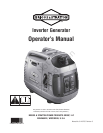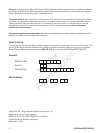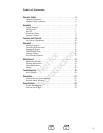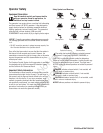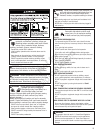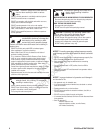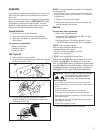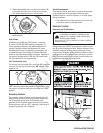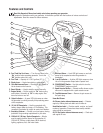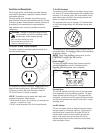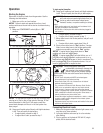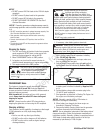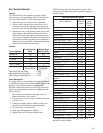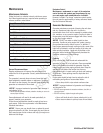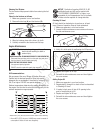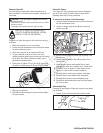
5
WARNING Running engine gives off carbon
monoxide, an odorless, colorless, poison gas.
Breathing carbon monoxide could result in death,
serious injury, headache, fatigue, dizziness,
vomiting, confusion, seizures, nausea or fainting.
• Operate this product ONLY outdoors.
• Install a battery operated carbon monoxide alarm near the
bedrooms.
• Keep exhaust gas from entering a confined area through
windows, doors, ventilation intakes, or other openings.
• DO NOT operate this product inside any building, carport,
porch, mobile equipment, marine applications, or enclosure,
even if windows and doors are open.
WARNING The engine exhaust from this product
contains chemicals known to the State of California to
cause cancer, birth defects, or other reproductive harm.
WARNING Certain components in this product and
related accessories contain chemicals known to the State
of California to cause cancer, birth defects or other
reproductive harm. Wash hands after handling.
WARNING
• This generator does not meet U. S. Coast Guard Regulation
33CFR-183 and should not be used on marine applications.
• Failure to use the appropriate U. S. Coast Guard approved
generator could result in death or serious injury and/or property
damage.
WARNING Fuel and its vapors are extremely
flammable and explosive which could
cause burns, fire or explosion resulting
in death, serious injury and/or property
damage.
WHEN ADDING OR DRAINING FUEL
• Turn generator engine OFF and let it cool at least 2 minutes
before removing fuel cap. Loosen cap slowly to relieve pressure
in tank.
• Fill or drain fuel tank outdoors.
• DO NOT overfill tank. Allow space for fuel expansion.
• If fuel spills, wait until it evaporates before starting engine.
• Keep fuel away from sparks, open flames, pilot lights, heat, and
other ignition sources.
• Check fuel lines, tank, cap and fittings frequently for cracks or
leaks. Replace if necessary.
• DO NOT light a cigarette or smoke.
WHEN STARTING EQUIPMENT
• Ensure spark plug, muffler, fuel cap, and air cleaner are in
place.
• DO NOT crank engine with spark plug removed.
WHEN OPERATING EQUIPMENT
• DO NOT operate this product inside any building, carport,
porch, mobile equipment, marine applications, or enclosure.
• DO NOT tip engine or equipment at angle which causes fuel to
spill.
• DO NOT stop engine by moving choke control to “Choke”
position
().
WHEN TRANSPORTING, MOVING OR REPAIRING EQUIPMENT
• Transport/move/repair with fuel tank EMPTY or with fuel shutoff
valve OFF.
• DO NOT tip engine or equipment at angle which causes fuel to
spill.
• Disconnect spark plug wire.
WHEN STORING FUEL OR EQUIPMENT WITH FUEL IN TANK
• Store away from furnaces, stoves, water heaters, clothes
dryers, or other appliances that have pilot light or other ignition
source because they could ignite fuel vapors.
WARNING Starter cord kickback (rapid retraction) will
pull hand and arm toward engine faster than you
can let go which could cause broken bones,
fractures, bruises, or sprains resulting in serious
injury.
• When starting engine, pull cord slowly until resistance is felt
and then pull rapidly to avoid kickback.
• NEVER start or stop engine with electrical devices plugged in
and turned on.
WARNING Storage batteries give off explosive
hydrogen gas during recharging.
Hydrogen gas stays near battery for a
long time after battery has been
charged. Slightest spark could ignite hydrogen causing
explosion resulting in death, serious injury and/or
property damage.
Battery electrolyte fluid contains acid and is extremely
caustic. Contact with battery fluid could cause chemical
burns resulting in serious injury and/or property damage.
• DO NOT allow any open flame, spark, heat, or lit cigarette
during and for several minutes after charging a battery.
• Wear protective goggles, rubber apron, and rubber gloves.
• DO NOT continue to charge a battery that becomes hot or is
fully charged.
• DO NOT leave battery unattended.
Not for
Reproduction



